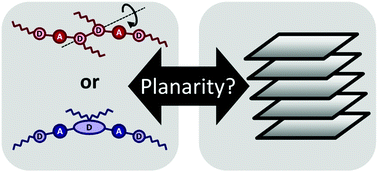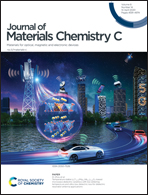What is the role of planarity and torsional freedom for aggregation in a π-conjugated donor–acceptor model oligomer?†
Abstract
Ordered domains play a central role in determining the properties of organic semiconductors, and thereby the performance of their devices. The molecules in these ordered domains are often characterized by planar backbone conformations. We investigate the influence of backbone planarity on the propensity to form ordered structures using a pair of model oligomers with electron poor benzothiadiazole moieties and electron rich thiophene units. The two oligomers differ by their central unit, where a bithiophene unit either allows for flexible twists (“TT”), or where it is bridged as a cyclopentadithiophene to provide a rigid planar connection (“CT”). Temperature dependent absorption and luminescence spectroscopy in solution along with atomistic simulations show that the more flexible TT readily forms aggregates upon cooling, while CT instead first forms non-emissive excimers and only forms aggregates below 200 K. Molecular dynamics simulations reveal that aggregation in TT can only be accounted for if TT takes on a planar conformation in the course of the aggregation process. The stronger intermolecular interaction in TT compared to the banana-shaped CT can then be related to the larger number of attractive intermolecular interactions between the various subunits. Thus, molecular flexibility is an important design parameter, as it determines the accessibility of ordered intermolecular structures and ultimately device performance.

- This article is part of the themed collection: Journal of Materials Chemistry C Advisory Board Collection


 Please wait while we load your content...
Please wait while we load your content...